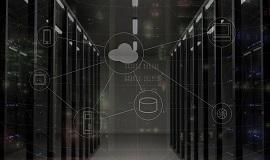Introduction
Currently, there are two types of servers: on-premises and cloud. On-premises is a form in which servers and network devices are installed and operated in the company’s building, whereas in the cloud, servers exist on the net and there is no need to have the hardware.

Various types of servers are used in businesses and government offices. There are various types such as a mail server that manages mail, a web server for setting up a homepage, and a file server for file sharing.
In the past, it was natural for these servers to have their server machines and manage them themselves. However, with the development of cloud technology in recent years, it is no longer necessary to have a server in-house.

Differences between on-premises and cloud
Currently, there are two types of servers: on-premises and cloud. On-premises is a form in which servers and network devices are installed and operated in the company’s building, whereas in the cloud, servers exist on the net and there is no need to have the hardware. In recent years, many companies have tended to move from on-premises environments to cloud servers.
That said, it’s never the case that all on-premises servers are gone. Both have their strengths and weaknesses, so it can be said that the operators have come to use them wisely while carefully assessing them. There are differences in cost, security, and customizability, but we will explain them in detail in “Advantages and Disadvantages of Moving from On-Premises to the Cloud.”
Items to consider when migrating to the cloud
Many companies originally had their on-premises services, so the current situation is that they are gradually migrating to cloud services. So what on earth should we move to the cloud? Before explaining that, let’s take a brief look at the types and characteristics of cloud technologies.

3 types of cloud services
Services generally called the cloud can be broadly divided into SaaS, PaaS, and IaaS.
SaaS is an abbreviation for Software as a Service, which is a service that provides software via the Internet. Typical examples include Google Apps, Salesforce, and Microsoft’s Office 365.
Next, PaaS is an abbreviation for Platform as a Service, which refers to a form in which a set of platforms is provided as a service on the Internet, and is a service mainly used by software vendors.
The last IaaS is an abbreviation of Infrastructure as a Service, which is a service that provides infrastructure as a service on the Internet. Well-known services include Google Compute Engine and his AWS Elastic Compute Cloud (EC2).
What you want to move to the cloud
Clouds generally introduced by businesses and government agencies are SaaS and IaaS.
Tools that are frequently used in business, such as text software and spreadsheet software, should be moved to the cloud. For example, there is Office365 (typical SaaS) mentioned above. The merit of introducing this system is that it used to be necessary to install and manage Microsoft Office via media such as CD-ROM and DVD for each PC in the office, but it is installed via the Internet. -License management has become easier. Furthermore, since it will be really easy to manage groupware, which was very troublesome to operate and manage on an on-premises server like SharePoint, companies that were suffering from such a burden will actively adapt it to perform sysadmin operations. And server management costs can be significantly reduced.
Companies that still use Office for media such as DVDs or use on-premises Windows servers should move to Office 365, considering the management effort.
Also, since services like Google and Salesforce are supposed to be used in the cloud from the beginning, introducing such services is nothing but introducing cloud services.
And let’s consider IaaS as well. IaaS such as Google Compute Engine and AWS Elastic Compute Cloud (EC2) can freely scale server performance and storage capacity depending on the situation. It is a convenient service for temporarily increasing the capacity of the server for consumer EC site operating companies, etc., whose access is likely to increase at once during the campaign period, mainly for services on the Web.
Therefore, it is very effective to move a part of the EC site server to the cloud instead of putting it in-house, considering the cost and management effort.
The flow of moving from on-premises to the cloud
Here are some specific ways to move from on-premises to the cloud.
Moving from on-premises to the cloud requires a two-step “cloud” process.
The first is a private cloud. If the on-premises server environment was built directly on the physical server, move it to the virtual environment created using VMWare or the like. Such an environment is called a private cloud. At first glance, it may seem meaningless, but virtualization has the advantage of facilitating recovery in the event of a failure and facilitating migration to the general cloud.
The second is the transition to the general cloud, that is, the public cloud. It is to migrate the private cloud to services such as AWS, but if a private cloud is built, it can be easily migrated using tools.
However, servers containing information that is prohibited from being taken out of the company due to security and compliance reasons, such as servers containing confidential information, must not be converted to the public cloud. In addition, some services can be taken out of the company but are rather expensive in terms of cost-effectiveness, so there is no need to migrate in such cases.
Advantages and disadvantages of moving from on-premises to the cloud
It’s a very convenient cloud system, but it’s not perfect. Naturally, if there are advantages, there are disadvantages.
So what are the advantages and disadvantages of moving from on-premises to the cloud?
Let’s list them below.
【merit】
- The initial cost is generally free, and you can start at a low cost.
- You can increase or decrease the number of servers as much as you need when you need them.
- It can be used immediately without installing a server machine or software.
- It is resistant to obstacles and can recover automatically even if it goes down.
- The facility is located in a robust building, so it is resistant to natural disasters.
- No maintenance is required.
- The OS and apps are automatically updated so that you can always use the latest ones.
【Demerit】
- The degree of freedom of customization and setting is low.
- Difficult to link with local networks. In some cases, it may not be possible.
- Since the OS and applications are automatically updated, it is inconvenient when you want to build an environment that depends on a specific version.
- If you depend too much on a particular company, the risk of trouble such as bankruptcy of that company is quite high.
From the above, we can see that it is not always the best way to make everything cloud-based, and it is better to use it properly on-premises depending on the situation.
There is an English saying, “Don’t put eggs in one basket.” This is often used in the sense that risk should be diversified just in case, but this is also an idea that can be applied to the proper use of cloud and on-premises.
Think carefully about what you want to cloud and what you want to keep on-premises.
In conclusion
If you compare it to a train, you can compare the cloud to a limited express train that can reach your destination in the shortest time, and the on-premises to a local train that stops at each station. Either one may be inconvenient or insufficient to achieve your goal.
Traditionally, the job of network administrators was to manage on-premises environments, but with the addition of the cloud, it became necessary to use them properly in consideration of cost-effectiveness and management effort. It will be increasingly required to properly select cloud or on-premises for each server.

